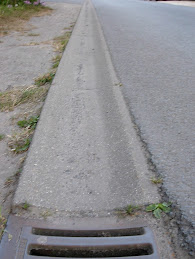I always thought that racing over cobblestones would be fun, exhilarating, and much smoother. I imagined the history and the tradition of the cobbled roads of Flanders and how awesome it would be to race over some of the same sections that are in The Classics. After a few races that incorporated cobblestone sections, I can officially say that there is nothing fun about racing over those wicked stones. Don't get me wrong, I still like racing on cobbles and want them to be part of the courses, but they are truly a pain in the ass, back, hands, wrist, arms, neck, fingers, knees, and just about every other part of your body.
I did a kermis that was held on a 5km circuit which included a 400 meter section of relatively smooth cobbles. The race was 25 laps long so the 12 guys who finished raced over 10km of cobbles! There is no such thing as smooth cobbles though. When I say relatively smooth I mean that at least one of your tires is in contact with the ground at any given moment or that the stones are close enough together that your tires won't get wedged in the crack. It is very true that a race in Belgium goes the hardest in the hardest sections, which means that cobbles are hell on a bike during a race. You're in pain simply because of the speed of the race but also because of the rattling and jarring of your intestines, brain, and bones while you maneuver the stones. It seems like every part of your body hurts over these sections. You may think that the pavement is sweet relief after the cobbles but it sometimes is worse because of the gaps that opened on the stones which need to be closed. Many a time the outcome of a race is determined on these historic stones. They tear races to shreds and blister your hands (seriously, they do).
In no way do I think that I am a master of racing over cobbles, but I have learned a thing or two about getting over them as quickly and easily as possible. It is very important how you place your weight, especially on a cobbled climb. I found that sitting on the front of the saddle with my hands on the tops works pretty well. I try to keep a very tight grip with my hands but at the same time keep my arms very loose to absorb shock. Pushing a big gear works much better than trying to spin. If you try to spin over cobbles you'll probably either get dropped or fall off your bike. As I grind a gear over the cobbles I try to think about my pedal stroke and use my up-stoke much more. I think it helps in stabilizing the core. Having a strong core is very important for racing over cobbles. You can tell who does and doesn't do core workouts every morning by watching people's upper body as they pedal over cobbles. Pacing longer sections of cobbles, like a smooth mountain climb, is important too. I have seen guys go too hard in the beginning of the section and then blow up and get dropped like a bag of rocks. The key to riding fast over cobbles, and I'm still working on it, is going steady, hard, and smooth.
I will never complain about rough roads in Michigan again. And I will laugh when I hear people complain about dangerous corners. I have done races here with a mini section of cobbles right through the corner! Oh, and I hope I never hear anyone ever refer to a road of laid bricks as cobbles... Not even close! In Belgium, cobblestones are the epitome of pain and I love 'em.
Happy Riding. VR
 team van
team van Brugge
Brugge
 The Butcher in Hertsberge
The Butcher in Hertsberge
 The bakery
The bakery the CC livingroom... spacious
the CC livingroom... spacious
 The injuries I sustained after my crash in Wervik.
The injuries I sustained after my crash in Wervik. My calf... powering over the cobbles in Tour of Antwerp
My calf... powering over the cobbles in Tour of Antwerp
 A beautiful day in Brugge
A beautiful day in Brugge


